Workplace diversity has been a hot topic for decades. Most of us have been through diversity training once or twice. So, what’s different now? The social climate.
Interracial marriages account for 12% of U.S. marriages according to Pew Research Center, and are celebrated this year, 50 years after becoming fully legal in all U.S. states. Transgender has been a blazing debate since Caitlyn Jenner publicized the transformation, and public bathrooms became politicized. Racial and ethnic issues are a regularly in the headlines, whether it’s a march or a terrorist attack. Baby Boomers have surpassed the age of 40, and many are expected to work well past the traditional retirement age.
How does this translate to the workplace?
In today’s U.S. workforce, nearly one-third of all workers are minorities. This percentage is increasing and expected to be 40% by 2020, and nearly 50% by 2050. But, diversity goes well beyond ethnicity. Workplace diversity takes into account gender, age, race, color, country of origin, religion, sexual orientation, and mental and physical special talents and special needs.
We are all different in some way, whether it be physical characteristics like height, hair or eye color, or cultural differences like the way we dress, or the holidays we celebrate. In fact, many differences are within groups rather than between them. Many people find they have more in common with someone of a different race, gender, religion, nationality, or age, than they do with someone of the same race, gender, religion, nationality, or age. Whether differences or commonalities, all workers should show respect by treating people of all kinds with professional courtesy.
Diversity Challenges and Opportunities
Regardless of how well your workplace exemplifies respect and professional courtesy, challenges may arise. Differences can create tension, especially when viewed as “better” or “worse” instead of just “different”. Different working and communication styles can be challenging as well. Everyone needs to be flexible and willing to adapt to a changing workplace. Open and clear communications is the key to working with a diverse group.
Along with the challenges, are opportunities. Having a diverse workforce, the organization gets a variety of perspectives, experiences, specialized knowledge, and abilities. Decision-making can be improved when there are numerous approaches in the workplace. Morale and productivity increase when everyone feels welcome and appreciated, regardless of background. The organization’s ability to compete globally may also be strengthened as a result of a diverse workforce.
Different Yet the Same
Regardless of the social climate, in many ways, we are all different and in many ways, we are all the same. Treating people as individuals, instead of members of a certain group will create an inclusive environment where all employees are welcomed and valued.




No comments yet. You should be kind and add one!
The comments are closed.